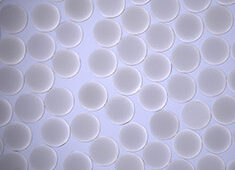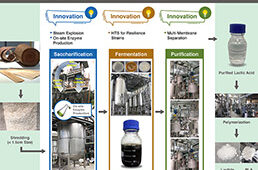 Battelle Memorial Institute scientists have invented a novel, water-based polyurethane unlike any other—environmentally responsible, cost-effective, soy-based, and free of N-methyl-2-pyrrolidone (NMP) solvent. This new polyurethane has less odor than its petroleum-based counterpart and can be used in a wide variety of coatings and adhesives.
Battelle Memorial Institute scientists have invented a novel, water-based polyurethane unlike any other—environmentally responsible, cost-effective, soy-based, and free of N-methyl-2-pyrrolidone (NMP) solvent. This new polyurethane has less odor than its petroleum-based counterpart and can be used in a wide variety of coatings and adhesives.
Both proof of principle and lab scale testing were established at Battelle. Surprisingly, though, the new product didn’t emerge from a high-level R&D program. A junior staff researcher taking part in a training course came up with the idea, and with the help of a Battelle scientist he successfully developed the product over an 18-month period.
“We have a formal mentorship program here. One of our senior scientists who has a background in the paint industry and has a background in polyurethane dispersion was mentoring a junior staff member and they were working with several materials,” says Rick Heggs, senior marketing manager at Battelle.
The key building block they used was a polyol, a soy-based product that has already been commercialized through the efforts of Battelle and Emery OleoChemicals LLC. Since 2011, researchers at both organizations have been looking at a new polyol-based products such as adhesives, coatings, and flexible foams.
“While they were investigating the water-based polyurethane space, they came up with a concept to make the materials in way as to eliminate any of the NMP solvent, and as they continued to refine it they were able to eliminate all solvents. It’s apparently a solvent-free system,” says Heggs.
Senior Research Scientist Ram Lalgudi presented a paper on the subject at conferences earlier this year. Lalgudi mentored Researcher Phil Denen, a young scientist at Battelle who started the idea and worked on weekends and off-work hours to develop it. Battelle has intellectual property based on the product and has filed for a patent.
According to Battelle, the new product is environmentally superior to petroleum-based alternatives on two levels. First, it employs soy oil instead of petroleum to produce the polyol needed to make standard polyurethanes. Second, water-based polyurethanes must have NMP added during the manufacturing process in order to lower viscosity. Battelle’s proprietary recipe eliminates the need for that expensive solvent, an important new breakthrough that reduces costs, handling, reporting regulations, vapors, and pollution.
“Yes, this new product is important for the consumer because it’s environmentally friendly and does the same job at a comparable price as older polyurethanes without using volatile organic solvents such as NMP,” says Heggs. “But for manufacturers, this represents a leap forward. Eliminating NMP makes life a lot easier.”
Heggs says that NMP is already limited in its volume of use in various products because of regulations. Doing away with NMP and other solvents completely will simplify things for developers of polyurethane products, he says, and offer a cost advantage.
Applications for the new product include all kinds of paints, inks, top coatings, seal coatings, and also will be valuable in the peel-and-go market and a variety of adhesives. It meets Chemical Agent Resistant Coatings (CARC) standards, which means it will be usable by the military. Battelle will seek licensing partners to scale up the product to mass manufacturing.
Battelle’s formal mentoring program was funded by Ohio soybean farmers through the Ohio Soybean Council (OSC).
“Once again, our friends at Battelle have developed a remarkable new product that takes advantage of the versatility of soybean oil,” said Keith Roberts, OSC New Uses Committee Chair and soybean farmer from Marion County, Ohio. “Our investment in research to develop new products made from renewable, environmentally friendly soybeans benefits everyone, including Ohio and all U.S. soybean farmers.”
The new polyurethane is the latest in a line of inventions that have come from the relationship between Battelle and the OSC, including such soy-based products as printer ink/toner, plastics, de-icers, hydrogels and many others.
Source: Battelle




